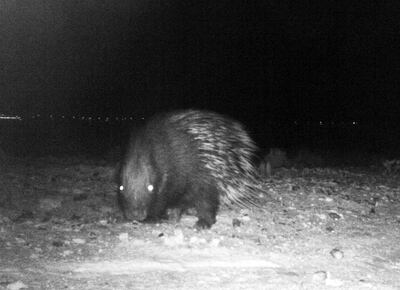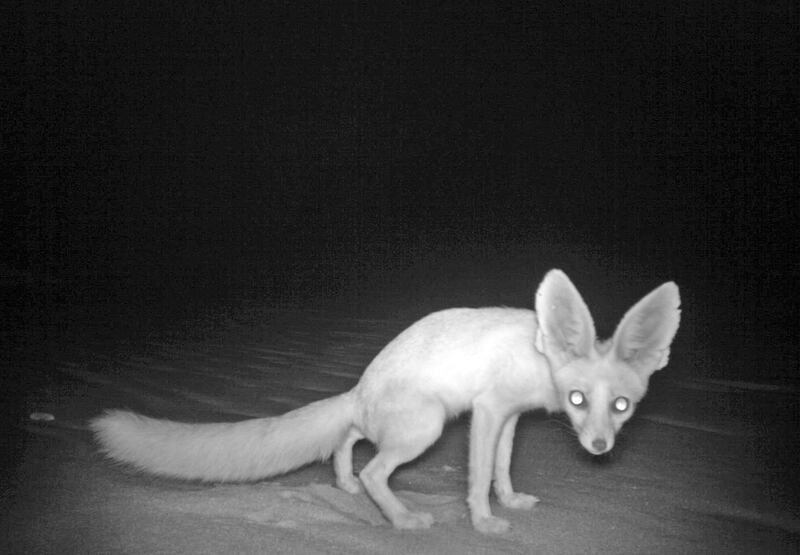A rodent thought to be extinct in Abu Dhabi is among two animals that have been caught on camera, bringing hope that other endangered critters may also be living in the emirate - however elusively.
Camera traps deployed by the Environment Agency – Abu Dhabi snapped a photo of the Crested Porcupine, the rodent, and the Rüppell's Fox (Vulpes rueppellii), which was last recorded in the agency's environmental database 13 years ago.
Camera traps are remotely activated cameras that use different types of sensors or light beams as a trigger. They are used to capture digital images of animals when researchers are not present and have proven useful in studies of nest ecology to help detect rare species or to estimate population size and species richness.
“This is a major find as it shows that with intensive monitoring and assessment and the use of innovative technology such as camera traps there could be new and exciting findings as the one we have just rediscovered,” said Dr Shaikha Al Dhaheri, executive director-terrestrial and marine biodiversity sector.
The Crested Porcupine, known to scientists as Hystrix cristata, can weigh up to 18 kilograms and is the largest rodent in the Middle East. The animal is nocturnal and hides in burrows, making it particularly difficult to spot. While there are known populations in Saudi Arabia and Oman, in the UAE the Crested Porcupine has very few confirmed sightings with records mostly coming from Bedouins in the early 20th century.

The porcupine was thought to be technically extinct from Abu Dhabi until, in December 2017, EAD scientists found footprints and quills at a site in the Al Dhafra region. A set of camera traps were deployed at the site and, within the same month, the team captured images of the elusive species. At this point in time, this is the only known location for this species in the Abu Dhabi emirate.
Rüppell's Fox, also known as Desert Fox, is one of three fox species found in the UAE. It is pale-coloured with large, bat-like ears, a short snout and a large bushy tail. A small animal, weighing less than two kilograms, it lives in dens and feeds on small mammals, reptiles and invertebrates.
The species is considered very rare and difficult to spot in the wild. EAD’s database has records of Rüppell's Fox since the early 1990s and the last confirmed sighting was recorded in 2005. Searching for new clues, EAD scientists deployed camera traps in two locations where the animal had previously been sighted. A year later, the effort paid off and one individual was seen at a location in the Western Region.
“We believe that the “re-discovery” of the fox in those areas is a good sign that the habitat is well-preserved naturally,” said Pritpal Soorae, unit head - terrestrial assessment and monitoring at EAD.
_____________
Read more:
Rarely sighted fox species photographed in RAK mountains
Hope for Arabian sand cats despite death of three kittens
Deathstalker scorpions and saw-scaled vipers: meet the poisonous creatures of the UAE
_____________
The agency uses more than 35 camera traps to monitor ecologically sensitive habitats and some newly-formed protected areas. One objective of the project has been to re-discover historical species. This involved going over records in Abu Dhabi’s Environmental Database. Once sites with historic records of rare animals were identified and located, the scientists set up camera traps.
This approach has helped the team record more than 17 locations with Arabian Sand Cats in the Al Dhafra region. This species was previously thought to be in serious decline in the wild with only a few isolated individuals remaining.
The information collected via the camera traps helps to formulate the agency’s conservation programmes and assists in the development of targeted conservation plans.
Rashed Al Zaabi, EAD Mammologist said the agency can intervene in cases where it feels urbanization or other factors are threatening the ecological balance and well-being of species.
“These eyes in the deserts will help in cryptic monitoring from afar, to see how nature works,” he said.





